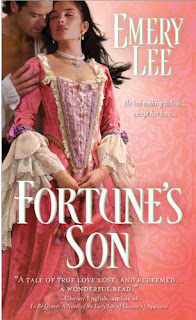 Welcome back Emery Lee who is with us today to talk about her latest release, Fortune’s Son. Emery visited us last year with The Highest Stakes, an incredibly well-researched debut set in the Georgian racing world.
Welcome back Emery Lee who is with us today to talk about her latest release, Fortune’s Son. Emery visited us last year with The Highest Stakes, an incredibly well-researched debut set in the Georgian racing world.
Lee brings the atmosphere of the Georgian era to life with lush descriptions that beg the reader to see, hear, feel and touch it all….suprising twists and turns that are reminiscient of Fielding’s Tom Jones or Defoe’s Moll Flanders — Kathe Robin, RTBookReviews
Fortune’s Son is the story of a complex and tumultuous romantic relationship between two people who despise and buck the world they live in but must maintain themselves in it nonetheless. Philip is a young adventurer, the disowned black sheep of an aristocratic family and Susannah Messingham is beautiful widow left upon her husband’s death with little means to support her extravagant lifestyle. While at an upscale gaming house she observes Philip winning at the tables and sets out to use her feminine wiles to persuade him to teach her. Philip, however, is not as malleable as she had hoped…
How did you come up with the idea for Fortune’s Son?
Philip and Susannah (Sukey to her intimates) are major secondary players in my first novel, The Highest Stakes, and characters who almost stole the book! Although part of their complex relationship is portrayed in my first book, I realized at the end of it that there was so much left to tell about them. How did they actually meet? What really drove them apart? Will they every have a happy ending? I had to write their story because they demanded that I do so!
What is risky about Fortune’s Son?
Honestly everything! Philip and Sukey are gamblers – people who rely on Lady Luck for even their daily bread. They are so very different yet mirror one another in many ways. She harbors a secret scandal and Philip is constantly at war with his family. She’s a widow with a social position to maintain and eight years older than Philip, who is virtually penniless, yet, the attraction between them is undeniable. Although clearly evident from their first meeting, they both fight it tooth and nail, but it is bigger than they are. In the end, however, love prevails and they are both shown to make tremendous sacrifices for one another.
Did you come up with any interesting research while writing this book?
Tons of stuff and almost all of it is in the book! I wanted to build the Georgian world as it has never been depicted in a romance novel – the sights, the sounds, the places and events that were part of my characters daily lives. This included everything from the play house to pugilism matches. I also incorporated many real historical figures into all of these scenes to make them more vivid. Two of my favorite scenes are Philip and George at the cockpit and the scene where Lord March tells Philip and George about his famous carriage race, a true event that I used in the resolution of my story.
“Why the clothes, dahling!”
What is next for you?
My very next release is actually an erotic historical romance novella, A BREACH OF PROMISE, from Ellora’s Cave. I’ve written it under the pseudonym Victoria Vane because it’s so unlike any of my other work in tone, style and sensuality level. It’s very light and witty but also very sexy, a story I like to think of as kind of Heyer-esque but with lottsa heat! My next Emery Lee project (PG13 again) is very exciting. It’s a full length romantic historical novel, working title, CHASING VENUS. Set in the mid- Georgian period, it involves science, discovery and high seas adventure between a couple who could not be more diametrically opposed to one another if they tried. For readers who relish conflict in a romance – it’s sure to deliver!
Diane, here, again. You’ve all read lots of historicals. Name any game of chance that was popular during the Georgian period. Or ask Emery a question. Make a comment for a chance to win a copy of Fortune’s Son.








